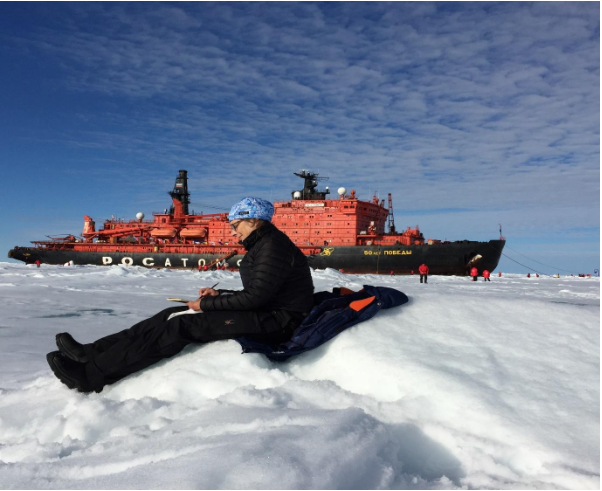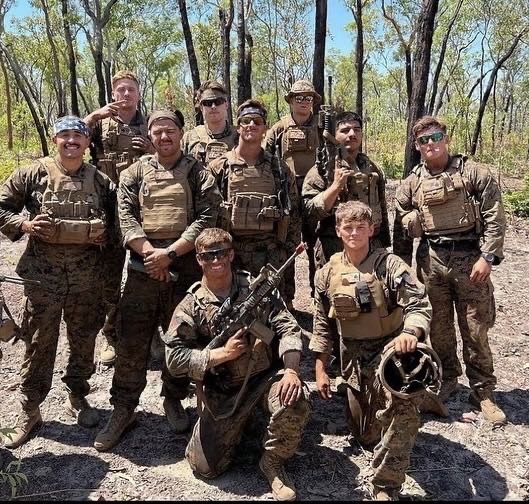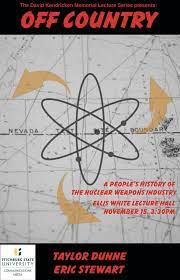
By Meena Roy
“History is personal,” Siebel tells the audience in the Ellis White lecture hall amidst a stunning photo backdrop of a polar bear jaw bone that belonged to her grandfather, Dr. John Colin Vaughan. The history behind her grandfather’s perilous 1903 Ziegler Polar expedition and experience being marooned on the Franz Josef Land Archipelago for two years largely influenced her remarkable career and artwork.
The multimedia artist and Fulbright Scholar from Cambridge, MA, earned her M.F.A. from Yale University. Siebel has taught at Wellesley College, Massachusetts College of Art, Rhode Island School of Design, and Harvard. Collections of her work are displayed at the Museum of Fine Arts, Boston; the DeCordova Museum, Lincoln, MA; the Boston Public Library; and the Yale Art Gallery, among other locations. Heddi has devoted more than two decades of her life to reconcile her grandfather’s failed polar expedition.
Vaughan’s polar bear artifact and journal entries along with family tales about his expedition captivated Heddi as a child. Through these relics, she discovered her grandfather’s voice for the first time and the desire to explore the Arctic region as he did.
Vaughan’s journal entry from Easter Sunday 1904, read: “I will never try it again” following two failed attempts to cross the sea ice to the North Pole. Such words warranted a personal investigation. Heddi went to task with her own journeys, retracing Vaughan’s ship’s path to the Arctic in 1998 and between 2015-2018. Siebel sought to understand why her grandfather made such a declaration, through her artwork.
Short films, paintings, still photos, installations, and personal interviews with descendants are some of the artistic outcomes of Siebel’s efforts to reinvent and understand her grandfather’s disappointment: his sense of defeat and the uncertainty he would ever return home. To demonstrate the psychological impact of the expedition on Vaughan, Siebe’s art re-interprets real experiences and true historical research through a poetic lens.
Siebel labored to interpret and recreate Vaughan’s experience with in-depth research of archival materials, including primary journals and the photography from the expedition, produced by its commander, Anthony Fiala. During her research, Siebel discovered Fiala’s extensive portfolio and learned that his 35mm films were the first to be shot in the Arctic region. One of her favorite experimental works, the (2011) short film, Far, and Further, collages together her footage and animations with clips from Fiala’s archival footage and voice over texts from the original journals. The images and sounds weave together an authentic piece that portrays a journey of hope and disenchantment, reviving memories that were frozen in time.
“To walk on the sea ice is the most amazing experience I’ve ever had,” Siebel says, describing her experiences at the North Pole as “transformative.” There were many opportunities for this during her 2015-2018 voyage on the Russian ice breaker ship, The Fifty Years of Victory, which is seven stories high and the length of two and a half football fields. While teaching art workshops and giving history lectures on the ship, Siebel made ten trips to the North Pole and another short film, (2017) The Cruise, a life-size three channel installation piece. Siebel’s film highlights the surreal experience of the voyage with scenes and sounds of life on the ship and the passengers in the Arctic region.
In July 2018, Siebel was invited by the Russian Arctic National Park to live in a Soviet era polar camp, Bukhta Tikhaya, or Calm Bay, on Hooker Island in Franz Josef Land for six days. Between 1929-1959, Bukhta Tikhaya was an all-season research station with approximately 15 buildings and up to 60 scientists living there. Now, the station is an outdoor museum within the national park that receives around 1,000 tourists during the summer season. She was one of the first Americans to live in Franz Josef Land since the Soviets occupied the territory in 1929. Siebel explained that the invitation and approval process was particularly difficult, and took five months to authorize all the permits, because Franz Josef Land is Russia’s Western front and supervised by Border Patrol.
During her stay, Siebel lived with 17 Russian scientists, historians, and park rangers, exploring the abandoned houses, walking the unusual arctic terrain, and discussing their projects. She gave up on outdoor painting in the evenings when she learned that an armed guard would be required to combat potential polar bear encounters. She was intrigued by the visitors’ attempting to personalize their experience of the Arctic through costume and lay claim to the North Pole, wondering if Bukhta Tikhaya would become a tourist destination or maintain its dedication to scientific research.
Retracing Vaughan’s footsteps and living in the places he had been “gave me this emotional rush,” Siebel recalls and left her with a new perspective of his expedition. She experienced the difficulty in crossing the ice firsthand, and no longer viewed his expedition as a failure. In fact, she realized the opportunities and creativity borne from her grandfather’s voyage, “I felt it was a step that they took that prepared maybe for the next people.” Siebel’s journey enabled her to reconstruct memories of her grandfather, discover answers to lingering questions, and create many successful art works, interpreting her travels. She hopes that her work portrays “wonder, drama, and discovery,” with an emphasis on actual experiences to viewers, revealing one of her goals with this project, “I want you to see something that comes out of the ‘gray,’ that comes out of the fact that nothing is black and white.”
Art has been in Heddi’s family since she was a child, and she enjoys the comfort that the studio setting provides. The natural world and painting are also passions of hers, both of which inspire most of her pieces. While discussing her work, Siebel concludes, “I think vulnerability is probably a connector that goes through all the work… the vulnerability of the landscapes, everything is very delicate, and… I’m trying to point that out.” Ultimately, Siebel wants her journey to inspire others to do an in-depth project and make new discoveries. Real experiences and curiosity can take one far in life and artmaking. Siebel advises, “allow yourself to have a dream – don’t do it because of the things it’s going to get you, do it because of the things it gives you.”
Categories:
My Journey: Heddi Vaughan Siebel's Voyage of Artmaking
May 15, 2019
0







